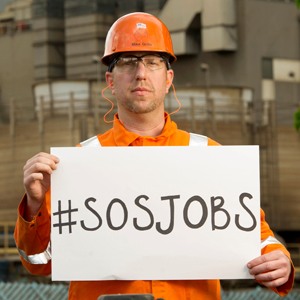Save America’s Steel Jobs, President Trump
 The Trump administration is concerned the domestic steel industry, shocked by massive global overcapacity and layoffs, may not be able to supply U.S. defense needs in a time of crisis or conflict.
The Trump administration is concerned the domestic steel industry, shocked by massive global overcapacity and layoffs, may not be able to supply U.S. defense needs in a time of crisis or conflict.
Say what you will about this president, but when it comes to this he has a point: Steel is a significant input in many military applications, and is essential to our critical infrastructure here at home. The American steel industry has been notably unstable, a result of massive distortions in the global market, caused mainly by China. This crisis has resulted in more than 14,000 steelworker layoffs in the past 18 months at a time it should be churning out more jobs, given our relatively healthy domestic economy.
President Trump had those layoffs in mind when he ordered an investigation into the national security implications of steel imports. He could use its results to take stabilizing actions such as tariffs, quotas, or a combination of both, to rebalance the steel market.
With rumors circulating that the investigation’s findings are imminent, the investigation’s critics have grown increasingly shrill.
The criticisms are mostly hypothetical or philosophical in nature, and can be easily refuted. Consider this myth:
President Trump is an antiquated outlier on trade policy in the international steel market.
The idea that Trump simply invented an issue around steel imports where there wasn’t one before is remarkably persistent. “If you look back at the 1980s and early 1990s when Japan was really booming,” one anonymous trade official told the Financial Times in March, “the same paranoia was in the air.”
They’d have you believe Trump is the only world leader worried about steel, but repeating a lie won’t make it so.
No one was saying that back in September, in fact — that’s when Trump was still a dark horse president candidate, Barack Obama was finishing his eighth year in office, and the G20 gathered for a summit in Hangzhou, China.
China ordered its regional factories to close to clean up the air quality and made a show of insulting President Obama with some tarmac shenanigans. But despite that pageantry, there was near consensus among the gathered economies that industrial overcapacity had to be reined in — and that China was largely responsible for feeding the global steel glut.
If anything, the problem is growing worse. China’s steel output reached an all-time high last month. And global institutions, ranging from the G-20 to the World Trade Organization, are ill-equipped to stop China’s state-driven steel industry from further destabilizing the global market. It’s worth noting that President George W. Bush and President Obama both intervened to stabilize the steel industry. Trump’s proposed intervention takes a different form, but the goal is quite consistent with past efforts.
Nevertheless, concerns about potential retaliation from a Presidential trade action have been hyper-inflated. And that leads us to another myth:
A tough 232 action will start a trade war.
First, it depends on what you mean by “start” a trade war. Some would argue — like the Trump administration — that we’re already in the midst of one.
It’s taken as granted that a tough response from a 232 investigation will generate backlash toward Washington. Even if other nations attempt to retaliate, the United States has had extraordinary success in nullifying those attempts at the World Trade Organization, and there is little doubt we would prevail again. A more likely outcome is that steelmakers in the European Union and elsewhere around the world will demand that their own governments pressure China to correct policies at cause for the steel market crisis.
And lastly, chew on this canard:
232 will cause prices to rise and create havoc for steel consumers.
Are you worried, like the Washington Post, that a can of Reddi Wip may suddenly cost more?
The critics warn that any action on the global steel imbalance will ultimately be felt by end-use consumers. But that’s a myopic way to look at what’s a systemic problem.
Might prices rise in the short term? Will the cost of your can of Reddi Wip, made with Japanese steel, rise? It the company passes along the cost to consumers, perhaps. But in the long term, a market-based system of global steel supply and demand is in everyone’s interests. And a global market flooded and distorted with steel from China’s state-owned steel industry crowds out real market competition.
Here’s what we know: Import relief will help the domestic steel industry. Laid-off workers will come back to the factory. Already investors are looking to re-open shuttered steel mills. The economy-wide impact of higher steel prices (if in fact they do rise) isn’t likely to even register.
The right thing to do from an economic perspective is to stabilize the global steel market, and that process begins with a robust Section 232 action.
***
This was reposted from Medium.

